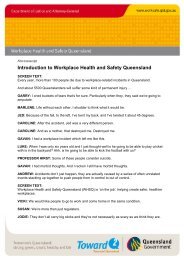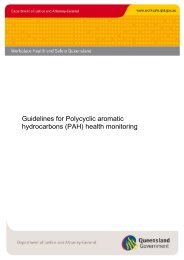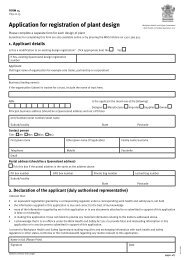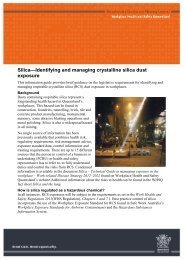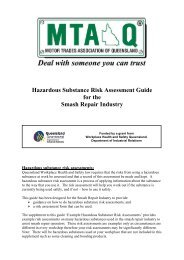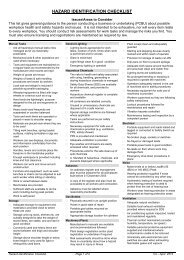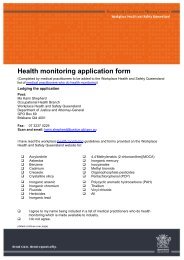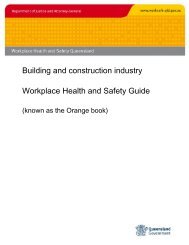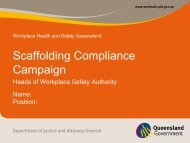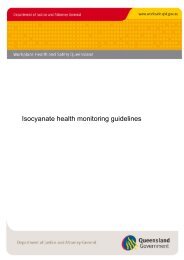DGSM Information Paper No.10 - Spills containment and clean-up ...
DGSM Information Paper No.10 - Spills containment and clean-up ...
DGSM Information Paper No.10 - Spills containment and clean-up ...
You also want an ePaper? Increase the reach of your titles
YUMPU automatically turns print PDFs into web optimized ePapers that Google loves.
CHEM Services<br />
C hemical Hazards <strong>and</strong> Emergency Management (CHEM) Services<br />
<strong>DGSM</strong> <strong>Information</strong> <strong>Paper</strong> No. 10<br />
<strong>Spills</strong> Containment <strong>and</strong> Clean-<strong>up</strong><br />
Measures for Dangerous<br />
Goods <strong>and</strong> Combustible Liquids<br />
under the<br />
Dangerous Goods Safety Management Act 2001<br />
December 2003<br />
Block C, Level 2, Emergency Services Complex, Cnr Park <strong>and</strong> Kedron Park Roads, KEDRON Qld 4031<br />
GPO Box 1425, BRISBANE Qld 4001<br />
Telephone: (07) 3247 8444 Facsimile: (07) 3247 8433<br />
Website: www.emergency.qld.gov.au/chem
TABLE OF CONTENTS<br />
1. Introduction .......................................................................................................................... 1<br />
2. Legislative requirements under <strong>DGSM</strong> ............................................................................. 1<br />
3. Guidance ................................................................................. Error! Bookmark not defined.<br />
3.1 The need for spills <strong>containment</strong> measures ....................................................................... 1<br />
3.2 Types of spills control <strong>and</strong> <strong>clean</strong>-<strong>up</strong> measures................................................................. 2<br />
3.3 Appropriate materials for use in spill <strong>containment</strong> measures .......................................... 2<br />
3.4 Capacity of spills <strong>containment</strong> systems for tanks ............................................................ 3<br />
3.5 Capacity of spills <strong>containment</strong> systems for package stores ............................................. 4<br />
3.6 Other Issues...................................................................................................................... 4<br />
3.7 <strong>Spills</strong> <strong>clean</strong> <strong>up</strong> measures .................................................................................................. 6<br />
3.8 Approach to spills management in small quantity scenarios ........................................... 7<br />
3.9 Sources of information..................................................................................................... 7<br />
Disclaimer<br />
Any representation, statement, opinion or advice, expressed or implied in this information<br />
paper is made in good faith but on the basis that the State of Queensl<strong>and</strong>, its agent <strong>and</strong><br />
employees are not liable (whether by reason of negligence, lack of care or otherwise) to any<br />
person for any damage or loss whatsoever which has occurred or may occur in relation to that<br />
person taking or not taking (as the case may be) action in respect of any representation,<br />
statement or advice referred to above.
1. Introduction<br />
This information paper provides guidance to occ<strong>up</strong>iers of premises in relation to the<br />
management of spills of dangerous goods <strong>and</strong> combustible liquids under the Dangerous<br />
Goods Safety Management Act 2001 (<strong>DGSM</strong> Act).<br />
2. Legislative requirements under <strong>DGSM</strong><br />
The Dangerous Goods Safety Management Regulation 2001 (<strong>DGSM</strong> Regulation) requires 1<br />
occ<strong>up</strong>iers of premises where dangerous goods or combustible liquids are present to contain<br />
<strong>and</strong> <strong>clean</strong> <strong>up</strong> a spill of those materials. Appropriate equipment <strong>and</strong> materials for <strong>clean</strong>-<strong>up</strong><br />
must be kept on h<strong>and</strong> <strong>and</strong> be readily accessible.<br />
The management of spills <strong>containment</strong> <strong>and</strong> <strong>clean</strong>-<strong>up</strong> is part of the general obligation under<br />
section 16 of the <strong>DGSM</strong> Act to take all reasonable precautions <strong>and</strong> care to achieve an<br />
acceptable level of risk from dangerous goods <strong>and</strong> combustible liquids.<br />
Risk is at an acceptable level when risk is minimised as far as reasonably practicable.<br />
(<strong>DGSM</strong> Act, section 17)<br />
While the Regulation requires only that spills be contained on site, effective management of<br />
the risk generally means that a spill should be contained as close to its source as possible. This<br />
prevents dangerous goods or combustible liquids from running across the site or workplace,<br />
adversely affecting employees, visitors, other on-site operations, other storage <strong>and</strong> h<strong>and</strong>ling<br />
systems, plant, vehicles <strong>and</strong> other structures.<br />
Because of the risk of fire, close <strong>containment</strong> with minimum surface area is critical for<br />
flammable <strong>and</strong> combustible liquids.<br />
3.1 The need for spills <strong>containment</strong> measures<br />
When determining whether you need to employ spills <strong>containment</strong> measures <strong>and</strong> how far you<br />
must go to minimise risk, consider the following factors:<br />
whether the goods are solid or liquid;<br />
the melting point <strong>and</strong> possible storage temperatures of any solids (important for low<br />
melting point solids);<br />
the behaviour of the materials in normal <strong>and</strong> abnormal storage conditions (e.g. fire);<br />
the viscosity of liquids;<br />
the quantity of dangerous goods or combustible liquids;<br />
the hazardous properties of the dangerous goods or combustible liquids (can they<br />
cause harm to people, property or the environment?);<br />
1 1 See sections 37, 39 <strong>and</strong> 73 of the <strong>DGSM</strong> Regulation<br />
<strong>DGSM</strong> <strong>Information</strong> <strong>Paper</strong> No. 10 <strong>Spills</strong> Containment <strong>and</strong> Clean-<strong>up</strong> (December 2003)<br />
CHEM Services Department of Emergency Services Page 1
consideration for the types of emergencies that may occur on site (fire, catastrophic<br />
collapse of a tank, gradual leaks, package punctures, transfer hose/pipeline r<strong>up</strong>tures,<br />
etc).<br />
the quantity of contaminated fire water that will have to be contained.<br />
3.2 Types of spills control <strong>and</strong> <strong>clean</strong>-<strong>up</strong> measures<br />
The type of measures employed may include the following:<br />
For <strong>containment</strong>:<br />
− bunding (<strong>containment</strong> walls around a storage area);<br />
− graded or sloping surfaces;<br />
− drainage to a holding pit, tank or sump;<br />
− trenches or spoon drains;<br />
− a combination of above means;<br />
− drip trays for small packages;<br />
− booms, s<strong>and</strong> bags <strong>and</strong> other devices to protect run off into water ways <strong>and</strong><br />
drains;<br />
− leak repair kits <strong>and</strong> other materials for temporary plugging of leaks from tanks<br />
or other vessels;<br />
For <strong>clean</strong>-<strong>up</strong>:<br />
− absorbent materials;<br />
− shovels, buckets, mops, bags, over-packs <strong>and</strong> other equipment;<br />
− pumps <strong>and</strong> transfer hoses;<br />
For effective management of spills, relevant procedures need to be developed <strong>and</strong> appropriate<br />
training given to employees in the hazards of the materials <strong>and</strong> in the procedures. All relevant<br />
procedures, training <strong>and</strong> other matters should be documented <strong>and</strong> incorporated into your<br />
safety management system.<br />
3.3 Appropriate materials for use in spill <strong>containment</strong> measures<br />
When selecting material <strong>and</strong> equipment to be used for spills <strong>containment</strong>, you should aim to<br />
ensure the following:<br />
That the materials will be impervious to the spilt material for the likely duration of the<br />
spill;<br />
The materials used in the construction of bunds or other spills <strong>clean</strong> <strong>up</strong> <strong>and</strong><br />
<strong>containment</strong> equipment are compatible with the dangerous goods or combustible<br />
liquids.<br />
Two or more materials are compatible if they do not react together adversely to cause<br />
a fire, explosion, harmful reaction, or evolution of flammable, toxic, or corrosive vapours.<br />
<strong>DGSM</strong> <strong>Information</strong> <strong>Paper</strong> No. 10 <strong>Spills</strong> Containment <strong>and</strong> Clean-<strong>up</strong> (December 2003)<br />
CHEM Services , Department of Emergency Services Page 2
When considering the use of materials for the construction of bund walls <strong>and</strong> other<br />
<strong>containment</strong> systems, ensure that the materials will not react adversely with the goods that the<br />
construction materials are meant to contain.<br />
For example, if a metal or galvanised metal surface were used with corrosive liquids such as<br />
hydrochloric acid, a reaction is likely to take place that would liberate hydrogen (a flammable<br />
gas). In the event of a spill, this material would cause an even greater hazard than the spill<br />
alone.<br />
If ordinary concrete were to be used, the hydrochloric acid could cause degradation of the<br />
concrete bund wall compromising the bund’s structural integrity <strong>and</strong> possibly leading to<br />
failure <strong>and</strong> loss of <strong>containment</strong>.<br />
For advice on compatibility, consult the relevant material safety data sheets or contact the<br />
manufacturer, importer or s<strong>up</strong>plier of the materials.<br />
3.4 Capacity of spills <strong>containment</strong> systems for tanks<br />
For a single tank, it is good practice to provide bunding or other spills <strong>containment</strong> measures<br />
that will contain at least 100% of the capacity of the tank, together with additional capacity<br />
for freeboard <strong>and</strong> fire water or foam. Many Australian St<strong>and</strong>ards 2 suggest additional<br />
capacity to contain at least 20 minutes of fire water from a hose or fixed fire protection<br />
system. You should consider the actual fire protection system output flow rate rather than the<br />
design flow rate, which may be lower.<br />
Where two or more tanks are stored within one <strong>containment</strong> system, it is good practice to use<br />
a general formula for determining capacity as follows:<br />
100% of the capacity of the largest tank (or IBC); plus<br />
25% of the total capacity of the tanks; plus<br />
An additional capacity for fire water or foam fire fighting systems.<br />
Ensure the displacement volume of any additional tanks is taken into account when<br />
determining the appropriate bund capacity.<br />
Tanks <strong>and</strong> Packages under <strong>DGSM</strong><br />
For Class 2 dangerous goods, a tank is a storage container with a capacity of 500 litres<br />
or more (equivalent water capacity).<br />
For other Classes of dangerous goods a tank is a container with either a net mass of<br />
400 kg or a capacity of 450 litres. Under this definition, an IBC is considered to be a<br />
“tank”.<br />
Anything smaller in capacity than a tank is classed as a package.<br />
2 A list of relevant Australian St<strong>and</strong>ards is provided at the end of this paper.<br />
<strong>DGSM</strong> <strong>Information</strong> <strong>Paper</strong> No. 10 <strong>Spills</strong> Containment <strong>and</strong> Clean-<strong>up</strong> (December 2003)<br />
CHEM Services, Department of Emergency Services Page 3
3.5 Capacity of spills <strong>containment</strong> systems for package stores<br />
For package stores it is recommended in most circumstances to apply the following approach<br />
to determine the capacity of the spills <strong>containment</strong> system:<br />
100 % of the capacity of the largest package; plus<br />
25 % of the maximum intended storage capacity <strong>up</strong> to 10 000 litres; plus<br />
an additional 10 % of the capacity in excess of 10 000 litres; plus<br />
an additional capacity for fire water.<br />
For example, if a package store contains 15,000 litres of packaged dangerous goods <strong>and</strong> the<br />
largest container is 200 litres, the <strong>containment</strong> capacity would be calculated as follows:<br />
200 + 2500 + 500 = 3200 litres plus additional fire water capacity<br />
3.6 Other Issues<br />
Storage of Incompatible Goods<br />
Occ<strong>up</strong>iers need to ensure that tanks of incompatible dangerous goods are never stored within<br />
the same spill <strong>containment</strong> area. Tanks of incompatible goods should be located in separate<br />
spill <strong>containment</strong> areas.<br />
Incompatible dangerous goods must not be stored in the same spill catchment area because<br />
of the potential for the materials to react dangerously together. Other compatible dangerous<br />
goods may be stored in the same catchment area provided appropriate distances are observed.<br />
At least 3 metres segregation distance would be appropriate for goods that do not react<br />
dangerously.<br />
All incompatible dangerous goods of Packing Gro<strong>up</strong> I or II should be assumed to react<br />
dangerously, unless it can be proven otherwise. Concentrated acids <strong>and</strong> alkalis are examples<br />
of incompatible goods that may react dangerously together.<br />
Distance from containers to bund wall<br />
Bunded compounds need to be constructed so as to ensure that punctures or r<strong>up</strong>tures of<br />
containers do not cause a jet of liquid to pass over the edge of the bund wall. Certain<br />
minimum distances should be maintained between any container <strong>and</strong> its bund wall.<br />
Many Australian St<strong>and</strong>ards recommend at least 1metre distance between a tank wall <strong>and</strong> its<br />
bund wall, measured from the top inside edge of the bund wall to the outermost edge of the<br />
tank surface.<br />
This distance may increase depending on the height of the container. A good rule of thumb is<br />
to ensure that containers sit further from the top inside edge of the bund wall than the line<br />
defined by angle A in Figure 1 3 (the illustration is for a horizontal cylindrical tank on a st<strong>and</strong>).<br />
The distance to the bund wall should ensure that the angle A is more than 26.5˚. In other<br />
words, the ratio of the horizontal distance over the vertical distance from the tank edge must<br />
be greater than 0.5.<br />
3<br />
Adapted from Figure 5.2(b) in Australian St<strong>and</strong>ard AS 1940 “Storage <strong>and</strong> H<strong>and</strong>ling of Flammable <strong>and</strong><br />
Combustible Liquids”.<br />
<strong>DGSM</strong> <strong>Information</strong> <strong>Paper</strong> No. 10 <strong>Spills</strong> Containment <strong>and</strong> Clean-<strong>up</strong> (December 2003)<br />
CHEM Services, Department of Emergency Services Page 4
Bund wall<br />
Cylindrical tank<br />
on st<strong>and</strong><br />
Figure 1: Bund location relative to tank<br />
Determination of Angle “A”<br />
tan A = opposite/adjacent<br />
= ½<br />
= 0.5<br />
A = 26.5˚ (or more)<br />
An occ<strong>up</strong>ier may be able to demonstrate that reduced distances are acceptable due to viscosity<br />
or other considerations such as a splash barrier placed on top of a bund wall. Stacking of<br />
packages such as drums close to a bund wall is also problematic. A fallen package may<br />
r<strong>up</strong>ture, spilling its contents. If the stacked packages are positioned too close to the bund wall,<br />
a fallen package may l<strong>and</strong> outside the bunded area where spilled contents will not be<br />
contained. Again a barrier may be erected to overcome this.<br />
Locate pumps <strong>and</strong> other equipment outside the bund<br />
Pumps <strong>and</strong> other equipment should not be located inside the bunded compound, where they<br />
may be flooded by a spill.<br />
Drainage<br />
The drainage valve for a bunded compound should normally be kept closed. If the valve is<br />
left open, the compound will not be effective in containing a spillage.<br />
If rainwater accumulates in the compound, it should be removed because it reduces the<br />
effective capacity of the compound. Consideration could be given to providing a roof over<br />
the compound to reduce rainwater accumulation.<br />
Access <strong>and</strong> egress<br />
When considering spill <strong>containment</strong> design, provision for access <strong>and</strong> egress should be given<br />
careful consideration. Bunds or other spills <strong>containment</strong> systems should be designed to allow<br />
for the escape of a person in an emergency as well as facilitate ease of access to carry out<br />
maintenance, repair or emergency work. If fixed means of access, ladders or walkways are<br />
provided then it is recommended that these meet the requirements of AS 1657 “Fixed<br />
platforms, walkways, stairways, <strong>and</strong> ladders-design construction <strong>and</strong> installation”.<br />
<strong>DGSM</strong> <strong>Information</strong> <strong>Paper</strong> No. 10 <strong>Spills</strong> Containment <strong>and</strong> Clean-<strong>up</strong> (December 2003)<br />
CHEM Services, Department of Emergency Services Page 5
Housekeeping<br />
Housekeeping in spills <strong>containment</strong> systems such as<br />
bunded areas is important. The bunded compound<br />
should not be cluttered with debris <strong>and</strong> packages or<br />
other materials that may contribute to a fire or take <strong>up</strong><br />
the bund capacity. Figure 2 shows an example of poor<br />
housekeeping practices in a bunded area filled with<br />
rubbish <strong>and</strong> left over containers.<br />
Figure 2: Poor housekeeping<br />
in bunded area<br />
3.7 <strong>Spills</strong> <strong>clean</strong> <strong>up</strong> measures<br />
General<br />
<strong>Spills</strong> must be <strong>clean</strong>ed <strong>up</strong> as soon as possible. Where practicable, recovery of spilled materials<br />
for re-use is preferable to disposal. Work procedures, safety management systems <strong>and</strong><br />
training ought to address safe work methods <strong>and</strong> the types of equipment for spills <strong>clean</strong>-<strong>up</strong><br />
<strong>and</strong> re-use/disposal. Advice on how to <strong>clean</strong> <strong>up</strong> spills safely <strong>and</strong> selecting appropriate<br />
protective equipment <strong>and</strong> resources can be obtained from the manufacturer’s MSDS. Many<br />
relevant Australian St<strong>and</strong>ards also provide good advice.<br />
Equipment<br />
Any premises where liquid dangerous goods or combustible liquids are stored or h<strong>and</strong>led<br />
needs to have a spills kit/s that contains appropriate materials <strong>and</strong> equipment. The types of<br />
materials <strong>and</strong> equipment needed to <strong>clean</strong> <strong>up</strong> spills will vary depending on the nature <strong>and</strong><br />
quantity of goods stored or h<strong>and</strong>led. The kit should be regularly maintained. Suitable<br />
materials <strong>and</strong> equipment may include the following:<br />
absorbent materials in sufficient quantities:<br />
− s<strong>and</strong>, kitty litter, fuller’s earth, etc;<br />
− proprietary absorbents (sheets, rolls, pillows);<br />
neutralising media such as:<br />
− sodium carbonate (washing soda), calcium hydroxide (hydrated lime) or<br />
calcium carbonate (limestone) for acidic spills;<br />
− citric acid or acetic acid for alkaline spills;<br />
− sodium bicarbonate (baking soda) for both acidic <strong>and</strong> alkaline spills;<br />
equipment for recovering spilled materials, such as:<br />
− shovels <strong>and</strong> scoops;<br />
− portable pumps <strong>and</strong> hoses for transferring spilt liquids (suitable for the<br />
liquids);<br />
containers for recovered materials such as:<br />
− impervious to <strong>and</strong> compatible with the spilled materials;<br />
− over-packs (for placing leaking drums within);<br />
personal protective equipment such as:<br />
− chemical boots, splash aprons, splash shields, respiratory protection. Refer to<br />
manufacturer’s MSDS for advice.<br />
<strong>DGSM</strong> <strong>Information</strong> <strong>Paper</strong> No. 10 <strong>Spills</strong> Containment <strong>and</strong> Clean-<strong>up</strong> (December 2003)<br />
CHEM Services, Department of Emergency Services Page 6
3.8 Approach to spills management in small quantity scenarios<br />
Where very small quantities of dangerous goods or combustible liquids are stored or h<strong>and</strong>led<br />
(e.g. consumer packages) it may not be necessary to use expensive spills <strong>containment</strong> systems<br />
such as bunded compounds.<br />
However, it will still be necessary to ensure that simple spills <strong>containment</strong> systems <strong>and</strong><br />
procedures are put in place. For example, it may be appropriate to place drip trays underneath<br />
small packages of hazardous liquids <strong>and</strong> to provide appropriate absorbent materials <strong>and</strong><br />
protective equipment.<br />
3.9 Sources of information<br />
The following Australian St<strong>and</strong>ards may provide guidance in relation to spills management<br />
for dangerous goods <strong>and</strong> combustible liquids:<br />
AS 1894-1997<br />
The storage <strong>and</strong> h<strong>and</strong>ling of non-flammable cryogenic <strong>and</strong><br />
refrigerated liquids<br />
AS 1940-1993 Storage <strong>and</strong> h<strong>and</strong>ling of flammable <strong>and</strong> combustible liquids<br />
AS 2714-1993 The storage <strong>and</strong> h<strong>and</strong>ling of hazardous chemical materials-Class<br />
5.2 substances (organic peroxides)<br />
AS 4326-1995 The storage <strong>and</strong> h<strong>and</strong>ling of oxidizing agents<br />
AS 2507-1984 The storage <strong>and</strong> h<strong>and</strong>ling of pesticides<br />
AS 4081-1993 The storage, h<strong>and</strong>ling <strong>and</strong> transport of liquid <strong>and</strong> liquefied<br />
polyfunctional isocyanates<br />
AS 3780-1994 The storage <strong>and</strong> h<strong>and</strong>ling of corrosive substances<br />
AS 3833-1995 The storage <strong>and</strong> h<strong>and</strong>ling of mixed classes of dangerous goods in<br />
packages <strong>and</strong> intermediate containers<br />
AS 3846-1998 The h<strong>and</strong>ling <strong>and</strong> transport of dangerous cargoes in port areas.<br />
AS 2243.10-1993 Safety in laboratories Part 10 - storage of chemicals<br />
<strong>DGSM</strong> <strong>Information</strong> <strong>Paper</strong> No. 10 <strong>Spills</strong> Containment <strong>and</strong> Clean-<strong>up</strong> (December 2003)<br />
CHEM Services, Department of Emergency Services Page 7





